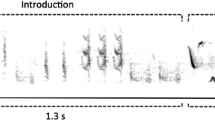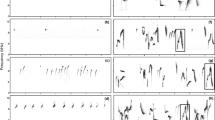Abstract
Documenting the diversity of vocal behaviour across different avian taxa is key to understanding the ecology and evolution of complex behaviours. Unique to Cozumel Island in the Mexican Caribbean Sea, the Cozumel Wren (Troglodytes aedon beani) provides an opportunity to investigate how isolation influences complex cultural traits. Most aspects of the biology, natural history, and taxonomy of Cozumel Wrens are unknown. In an attempt to better understand the Cozumel Wren’s biology, we provide the first description of the songs and the vocal behaviour of this island-endemic bird. Based on more than 700 h of recordings, including more than 36,000 songs, we describe the fine structural characteristics of male Cozumel Wrens songs, and explore patterns of repertoire organization and song sharing. Cozumel Wrens sing songs composed of highly variable syllables, with prominent trills at the end of each song. Each bird has a limited repertoire of songs, which they create by recombining a restricted number of syllable and trill types. They repeat a song type several times before switching to a different one, with some variation in the number of times they repeat specific elements. Cozumel Wrens share more song types with neighbours than distant individuals. Syllable sharing, however, is equivalent between neighbours and distant individuals. Our results provide important data for future research on the ecology, evolution, and behaviour of this island-endemic songbird, and for helping to clarify the taxonomic status of Cozumel Wrens.
Zusammenfassung
Stimmverhalten des inselendemischen Cozumelzaunkönigs ( Troglodytes aedon beani ): Gesangsstruktur, Lautrepertoires und Strophentypenverteilung
Die Dokumentation der Diversität des Stimmverhaltens über verschiedene Vogeltaxa hinweg spielt eine Schlüsselrolle beim Verständnis von Ökologie und Evolution komplexer Verhaltensweisen. Der Cozumelzaunkönig (Troglodytes aedon beani) kommt nur auf der Insel Cozumel in der Mexikanischen Karibik vor und bietet somit eine Gelegenheit zu untersuchen, inwieweit Isolation komplexe kulturelle Merkmale beeinflusst. Die meisten Aspekte der Biologie, der Naturgeschichte und der Taxonomie des Cozumelzaunkönigs sind noch unbekannt. Für ein besseres Verständnis der Biologie des Cozumelzaunkönigs stellen wir hier die erste Beschreibung der Gesänge und des Lautverhaltens dieser inselendemischen Vogelart vor. Auf der Grundlage von über 700 Stunden Aufnahmematerial, darunter mehr als 36.000 Gesänge, beschreiben wir die Feinstruktur der Gesänge männlicher Cozumelzaunkönige und untersuchen die Muster von Repertoireaufbau und Strophenverteilung innerhalb der Population. Die Gesänge der Cozumelzaunkönige bestehen aus hochgradig variablen Silben, und jeder Gesang endet in einem markanten Triller. Jeder Vogel hat ein limitiertes Gesangsrepertoire, das durch die Kombination einer begrenzten Anzahl von Silben- und Trillertypen gebildet wird. Ein Strophentyp wird mehrmals wiederholt, bevor zu einem anderen gewechselt wird; dabei variiert die Anzahl der Wiederholungen spezifischer Elemente. Cozumelzaunkönige haben mehr Strophentypen mit ihren Nachbarn gemeinsam als mit weiter entfernten Individuen. Allerdings haben Nachbarn ähnlich viele Gesangselemente gemeinsam wie weiter voneinander entfernt lebende Individuen. Unsere Ergebnisse liefern wichtige Daten für die weitere Erforschung von Ökologie, Evolution und Verhalten dieses inselendemischen Singvogels und können zur Klärung des taxonomischen Status des Cozumelzaunkönigs beitragen.




Similar content being viewed by others
References
Aleixandre P, Montoya JH, Milá B (2013) Speciation on oceanic islands: rapid adaptive divergence vs. cryptic speciation in a Guadalupe Island songbird (Aves: Junco). PLoS One 8:e63242
American Ornithologists’ Union (1998) Check-list of North American birds, 7th edn. American Ornithologists’ Union, Washington, DC
Baker MC (1996) Depauperate meme pool of vocal signals in an island population of singing honeyeaters. Anim Behav 51:853–858
Baker MC (2006) Differentiation of mating vocalizations in birds: acoustic features in mainland and island populations and evidence of habitat–dependent selection on songs. Ethology 112:757–771
Baker MC, Boylan JT (1995) A catalogue of song syllables of indigo and lazuli buntings. Condor 97:1028–1040
Baker MC, Baker MSA, Baker EM (2003) Rapid evolution of a novel song and an increase in repertoire size in an island population of an Australian songbird. Ibis 145:465–471
Baker MC, Baker MSA, Tilghman LM (2006) Differing effects of isolation on evolution of bird songs: examples from an island–mainland comparison of three species. Biol J Linn Soc 89:331–342
Banks RC, Cicero C, Dunn JL, Kratter AW, Rasmussen PC, Remsen JV Jr, Rising JD, Stotz DF (2006) Forty-seventh supplement to the American Ornithologists’ Union check-list of North American birds. Auk 123:926–936
Baptista LF, Johnson RB (1982) Song variation in insular and mainland California brown creepers (Certhia familiaris). J Ornithol 123:131–144
Brewer D (2001) Wrens, dippers, and thrashers. Yale University Press, New Haven
Camacho-Schlenker S, Courvoisier H, Aubin T (2011) Song sharing and singing strategies in the winter wren Troglodytes troglodytes. Behav Process 87:260–267
Campagna L, St Clair JJH, Lougheed SC, Woods RW, Imberti S, Tubaro PL (2012) Divergence between passerine populations from the Malvinas–Falkland Islands and their continental counterparts: a comparative phylogeographical study. Biol J Linn Soc 106:865–879
Catchpole CK, Komdeur J (1993) The song of the Seychelles warbler Acrocephalus sechellensis, an island endemic. Ibis 135:190–195
Catchpole CK, Slater PJB (2008) Bird song: biological themes and variations. Cambridge University Press, Cambridge
Chesser RT, Banks RC, Barker FK, Cicero C, Dunn JL, Kratter AW, Lovette IJ, Rasmussen PC, Remsen JV, Rising JD, Stotz DF, Winker K (2010) Fifty-first supplement to the American Ornithologists’ Union check-list of North American birds. Auk 127:726–744
Cramer ER (2013) Vocal deviation and trill consistency do not affect male response to playback in house wrens. Behav Ecol 24:412–420
Dingle C, Poelstra JW, Halfwerk W, Brinkhuizen DM, Slabbekoorn H (2010) Asymmetric response patterns to subspecies-specific song differences in allopatry and parapatry in the gray-breasted wood-wren. Evolution 64:3537–3548
Gómez de Silva H (1997) Comparative analysis of the vocalizations of Hylorchilus wrens. Condor 99:981–984
Holland J, Dabelsteen T, López Paris A (2000) Coding in the song of the wren: importance of rhythmicity, syntax and element structure. Anim Behav 60:463–470
Howell SN, Webb S (1995) A guide to the birds of Mexico and Northern Central America. Oxford University Press, Oxford
Ivanitskii VV, Marova IM, Malykh IM (2012) Between order and chaos: contrasting syntax in the advertising song of Dusky (Phylloscopus fuscatus) and Radde’s (Ph. schwarzi) Warblers. J Ornithol 153:337–346
Johnson LS (1998) House Wren (Troglodytes aedon). In: Poole A (ed) The birds of North America. Cornell Lab of Ornithology, Ithaca. doi:10.2173/bna.380
Johnson LS, Kermott LH (1991) The functions of song in male House Wrens (Troglodytes aedon). Behaviour 116:190–209
Johnson LS, Searcy WA (1996) Female attraction to male song in House Wrens (Troglodytes aedon). Behaviour 133:357–366
Kroodsma DE (1980) Winter Wren singing behaviour: a pinnacle of song complexity. Condor 82:357–365
Kroodsma DE (2004) The diversity and plasticity of birdsong. In: Marler P, Slabbekoorn H (eds) Nature’s music, the science of birdsong. Elsevier, London, pp 108–131
Kroodsma DE, Vielliard JME, Stiles FG (1996) Study of bird sounds in the neotropics: urgency and opportunity. In: Kroodsma DE, Miller EH (eds) Ecology and evolution of acoustic communication in birds. Cornell University Press, Ithaca, pp 269–281
Kroodsma DE, Woods RW, Goodwin EA (2002) Falkland Island sedge wrens (Cistothorus platensis) imitate rather than improvise larger song repertoires. Auk 119:523–528
Kroodsman DE, Brewer D (2005) Family Troglodytidae (wrens). In: del Hoyo J, Elliott A, Christie DA (eds) Handbook of the birds of the world, vol 10: cuckoo-shrikes to thrushes. Lynx Edicions, Barcelona, pp 356–447
Leger DW (2005) First documentation of combinatorial song syntax in a suboscine passerine species. Condor 107:765–774
Mann NIK, Dingess A, Slater PJB (2006) Antiphonal four-part synchronized chorusing in a Neotropical wren. Biol Lett 2:1–4
Mann NI, Dingess KA, Barker KF, Graves JA, Slater PJB (2009) A comparative study of song form and duetting in neotropical Thryothorus wrens. Behaviour 146:1–43
Marler P, Pickert R (1984) Species-universal micro structure in the learned song of the swamp sparrow (Melospiza georgiana). Anim Behav 32:673–689
McGregor PK, Krebs JR (1982) Song types in a population of great tits (Parus major): their distribution, abundance and acquisition by individuals. Behaviour 73:126–152
Mennill DJ, Battiston M, Wilson DR, Foote JR, Doucet SM (2012) Field test of an affordable, portable, wireless microphone array for spatial monitoring of animal ecology and behaviour. Methods Ecol Evol 3:704–712
Mirsky EN (1976) Song divergence in hummingbird and junco populations on Guadalupe Island. Condor 78:230–235
Molles LE, Verhencamp SL (1999) Repertoire size, repertoire overlap, and singing modes in the Banded Wren (Thryothorus pleurostictus). Auk 116:677–689
Morton ES (1987) The effects of distance and isolation on song-type sharing in the Carolina wren. Wilson Bull 99:601–610
Muckelbauer G (1990) The shelf of Cozumel, Mexico: topography and organisms. Facies 23:185–200
Navarro-Sigüenza AG, Peterson AT (2004) An alternative species taxonomy of the birds of Mexico. Biota Neotrop 4:1–32
Päckert M, Martens J (2004) Song dialects on the Atlantic islands: goldcrests of the Azores (Regulus regulus azoricus, R. r. sanctae-mariae, R. r. inermis). J Ornithol 145:23–30
Platt ME, Ficken MS (1987) Organization of singing in House Wrens. J Field Ornithol 58:190–197
Potvin DA (2013) Larger body size on islands affects silvereye Zosterops lateralis song and call frequency. J Avian Biol 44:221–225
Remsen Jr JV, Cadena JD, Jaramillo A, Nores M, Pacheco JF, Pérez-Emán J, Robbins MB, Stiles FG, Stotz DF, Zimmer KJ, American Ornithologists’ Union (2013) A classification of the bird species of South America. http://www.museum.lsu.edu/~Remsen/SACCBaseline.html. Accessed 14 June 2013
Romero-Nájera I, Cuarón AD, González-Baca C (2007) Distribution, abundance, and habitat use of introduced Boa constrictor threatening the native biota of Cozumel Island, Mexico. Biodivers Conserv 16:1183–1195
Rosenberg MS, Anderson CD (2011) PASSaGE: pattern analysis, spatial statistics and geographic exegesis. Version 2. Methods Ecol Evol 2:229–232
Stotz DF, Fitzpatrick JW, Parker TA III, Moskovits DK (1996) Neotropical birds: ecology and conservation. University of Chicago Press, London
Toews DP, Irwin DE (2008) Cryptic speciation in a Holarctic passerine revealed by genetic and bioacoustic analyses. Mol Ecol 17:2691–2705
Toews DP, Irwin DE (2012) Pacific Wren (Troglodytes pacificus). In: Poole A (ed) The birds of North America. Cornell Lab of Ornithology, Ithaca. doi:10.2173/bna.720
Tubaro PL (1999) Bioacústica aplicada a la sistemática, conservación y manejo de poblaciones naturales de aves. Etología 7:19–32
Valderrama SV, Parra JE, Mennill DJ (2007) Species differences in the songs of the critically endangered Niceforo’s Wren and the related Rufous-and-white Wren. Condor 109:870–877
Van Horne B (1995) Assessing vocal variety in the winter wren, a bird with a complex repertoire. Condor 97:39–49
Vehrencamp SL (1999) Handicap, index, and conventional signal elements of bird song. In: Espmark Y, Amundsen T, Rosenqvist G (eds) Animal signals: signalling and signal design in animal communication. Tapir, Trondheim, pp 161–184
Verner J (1975) Complex song repertoire of male long-billed marsh wrens in eastern Washington. Living Bird 14:263–300
Węgrzyn E, Leniowski K (2010) Syllable sharing and changes in syllable repertoire size and composition within and between years in the great reed warbler, Acrocephalus arundinaceus. J Ornithol 151:255–267
Wright TF, Dahlin CR (2007) Pair duets in the yellow-naped amazon (Amazona auropalliata): phonology and syntax. Behaviour 144:207–228
Acknowledgments
We thank O. Rojas-Soto, A. Gordillo, J. Martínez-Gómez, H. Perdomo-Velázquez, and M. López-Mejía for logistical assistance. We thank E. C. Fernandez-Martínez for field assistance. We thank G. Budney from the Macaulay Library of Natural Sounds for loaning us recording equipment. We thank O. Rojas-Soto for assistance with permits for mist-netting birds. We thank T. W. P. Friedl, L. S. Johnson, and an anonymous reviewer for valuable comments that significantly improved the manuscript. For funding, we thank the Consejo Nacional de Ciencia y Tecnología (CONACyT), Secretaría de Educación Publica de México (SEP), and the University of Windsor for scholarship support of J. R. S. L., and the Natural Sciences and Engineering Research Council of Canada (NSERC), the Canada Foundation for Innovation, and the Government of Ontario for grants to D. J. M.
Author information
Authors and Affiliations
Corresponding author
Additional information
Communicated by T. Friedl.
Rights and permissions
About this article
Cite this article
Sosa-López, J.R., Mennill, D.J. Vocal behaviour of the island-endemic Cozumel Wren (Troglodytes aedon beani): song structure, repertoires, and song sharing. J Ornithol 155, 337–346 (2014). https://doi.org/10.1007/s10336-013-1008-6
Received:
Revised:
Accepted:
Published:
Issue Date:
DOI: https://doi.org/10.1007/s10336-013-1008-6




